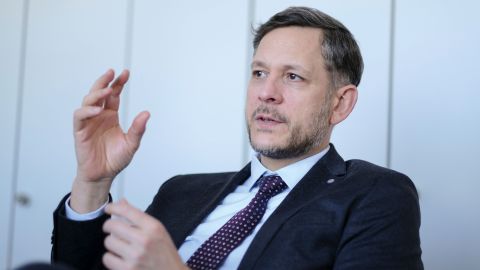The child cried and screamed: "Daddy, where's my daddy?" Over and over again. The situation was so unbearable that the investigators had to leave the room. They had persevered with the pictures, the videos. They had read the chats and knew what the "dad" had done to his daughter for years: disgusting. But now the tears, the desperate cries. It was too much. The cries of a child who loves her father because he is her father. "Daddy, where's my daddy?"
This moment - so unreal and yet so true - is etched in the memory of criminal director Michael Esser (55). When his people told him about the scene, he thought: "What else is normal? Will a child like that understand at some point that there is a life without abuse, or is all the dirt part of his life forever and ever because he learned as a baby that the wrong thing is the right thing?"
It's a question that continues to occupy Esser, head of the Special Organizational Structure (BAO) Berg, even after his departure. At the beginning of the year, the BAO Berg was dissolved with operational sections in the § 2 authorities. This structure is normally intended for terrorist attacks with multiple locations. It was deployed when officers arrested the perpetrator of abuse Jörg L. (44) in Bergisch Gladbach in October 2019. The investigators quickly realized that this was not a lone offender. And indeed, the case grew into one of the largest abuse complexes in Germany and even beyond its borders.
It was the beginning of a rethink in child sexual abuse investigations. The beginning of an operation in which up to 350 officers in eleven NRW district police authorities spent more than two years hunting down hundreds of paedophiles, mostly men who moved in the shadowy world of the internet, chatted about their preferences behind firewalls, uploaded deviant photos and videos, arranged to have sex and swapped baby-sized lingerie. In order to expose the perpetrators, most of whom are family members, new approaches were tried out that lead to the future and in whose development the "State Working Group on Child Pornography" (LAG KiPo), the state working group "IT-Asservate" and the "Child Pornography Staff Unit" were significantly involved:
- Public prosecutors from the Central Cybercrime Contact Point (ZAC) and investigators from the district police authorities work closely together.
- Uniform standards determine, among other things, how investigators in the NRW police headquarters proceed, for example, during arrests and house searches.
- State-of-the-art technology ensures that investigators from all district police authorities are networked with each other and also with the State Office of Criminal Investigation.
- The number of staff in the district police authorities has been increased. There are now 413 employees working on criminal investigation cases, more than three times as many as before Bergisch Gladbach.
"In more than 40 years of service, I have seen a lot of suffering, but what the employees at BAO Berg had to endure goes beyond all standards," summarized Cologne's former police chief Uwe Jacob at a final press conference. A total of 60 apartments were searched and 4,700 data carriers were seized: Computers, hard disks, smartphones, USB sticks. 13 of the 27 men and women arrested have already been sentenced to a total of more than 80 years in prison. But the most important thing: 65 children were freed. The youngest was still an infant - just three months old. "But despite the successes, we haven't achieved much with deterrence. Sexual abuse continues to take place in our society," said Jacob and announced: "Even if BAO Berg is formally over, the hunt continues."
The aim is to find the perpetrators in the endless expanses of the World Wide Web, who are constantly upgrading their technology and are even protected by data protection laws. While the BAO Berg was in the middle of its investigations, the next major case was underway in Münster. Following a tip-off about child pornography, investigators carried out a search at Adrian V.'s home and found, among other things, several servers on which huge amounts of child pornography were stored. The investigations have already led to 59 suspects. A total of 1.2 petabytes of data have been seized so far. That is a figure with 15 zeros. State-of-the-art technology was used to decrypt the data carriers. And once the results are available after the subsequent analysis, they in turn lead to new leads and other perpetrators who are networked with other criminals. "It's a Sisyphean task," says Senior Criminal Investigator Sven Schneider (47), who heads Department 43 "Central Evaluation and Collection Point for Child Pornography" (ZASt) at the State Criminal Police Office in Düsseldorf. The mainframe computer, on which thousands of gigabytes of data are already stored, is located at the LKA NRW.
The new KiPo workflow developed by the LAG KiPo provided for the state-centralized data processing as well as the state-centralized evaluation of the images and videos of all proceedings of the district police authorities in NRW at the LKA. By November 2020 alone, four million videos and 120 million photos had already been evaluated. However, it is not possible to evaluate the images and videos of all NRW proceedings of the NRW district police authorities on a state-wide basis due to the increase in the number of cases in the past two years alone. Artificial intelligence now also helps with searching and finding. "The police are now very far ahead digitally," says Schneider. But also: "The case numbers are running away from us. If we want to keep up, we have to reorganize and reassess our processes." Once again.
Always new technology. More and more data. When Schneider started at the LKA in 2018, there were just twelve investigators and digitalization was still a side issue. Just two months later, colleagues in Lügde arrested the long-term camper Andreas V. (57). The motivation to hunt even more intensively for perpetrators of abuse. Today, 19 police officers and 68 government employees at the ZASt sift through child pornography images and video files every day using state-of-the-art technology. "It's a fight against windmills," sighs Schneider.
One reason for this is that the BKA has been forwarding NCMEC data to the federal states since 2020. These are suspects with German IP addresses that a US organization tracks down online. It has sent almost 140,000 leads to Germany in the past two years alone. A further 120,000 are expected in 2022. Every fourth clue leads to Germany's largest federal state: North Rhine-Westphalia. Currently, 180 reports come in every week.
30,000 clues could be behind cases like Lüdge, Bergisch Gladbach or Münster. The thought is frightening, and the exponential increase in numbers even more so. But one thing is comforting: the successes are also increasing. On Schneider's desk on the fourth floor of Völklinger Straße in Düsseldorf, there is a PKS statistic with blue bars shooting up: they show the number of child pornography investigations, which more than doubled from 2,359 to 4,776 from 2019 to 2020 (up 104%) and again last year: 11,328 cases (up 137%) were evaluated in 2021 alone.
What's next? Four weeks after BAO Berg's review in Cologne, Schneider had an appointment with the Ministry of the Interior. The final report "Evaluation and investigation needs in the area of child pornography" was handed over. The state working group of the same name was founded in 2018. Successes and goals are listed on 38 pages and in eleven annexes. But much of it is already outdated. That is why there is a new working group in which police officers, public prosecutors and ministry officials from the federal and state governments are now jointly developing new standards on how to handle the masses of data in the future. For example, there is the question of whether everyone in a chat group with 1,000 people becomes a suspect because one individual has posted a child pornography photo. Or whether you always have to run a full program because a teenager has uploaded a forbidden picture to TikTok - with a house search, sniffer dog and all the trimmings. "Difficult topics. Because if we no longer turn over every stone, it also means that there will be blind spots that we have to deal with," says Schneider. The first results should be available in the fall.


